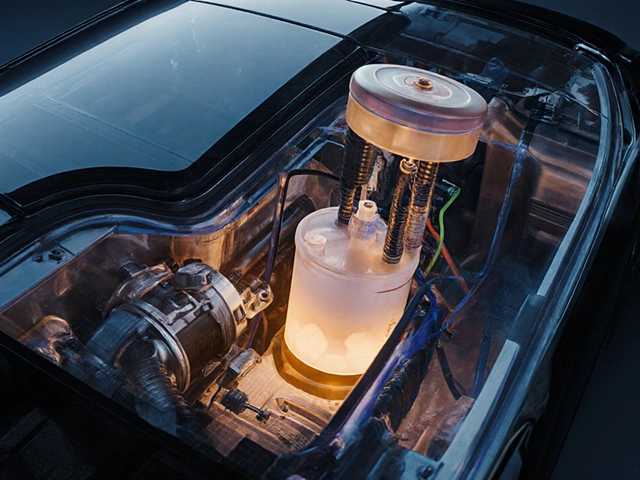When it comes to ensuring your vehicle's safety, understanding how to check for loose suspension is vital. Not only does this affect your driving experience, but it can also prevent dangerous situations on the road. A vehicle’s suspension system helps to absorb impact, maintain tire contact, and provide a comfortable ride.
Regularly inspecting the suspension system is something every driver should be familiar with, yet it's often overlooked. In this guide, I’ll walk you through the signs to watch for and offer simple steps you can take to check if your suspension parts are secure. With basic tools and keen attention, you'll be able to identify issues before they turn into expensive headaches.
Whether you're a seasoned car enthusiast or a new driver, knowing how to keep an eye on your vehicle's suspension can save you time and money. Plus, it's satisfying to keep your car running smoothly all on your own. Ready to dive in? Let's explore what makes a suspension system work and how to ensure it's in top shape.
- Signs of Suspension Problems
- Tools Needed for Suspension Inspection
- Step-by-Step Suspension Check
- Common Causes of Loose Suspension Parts
- Preventative Measures and Maintenance Tips
Signs of Suspension Problems
The suspension system in a vehicle plays a critical role in maintaining road grip, ensuring comfort, and above all, providing safety. Recognizing the signs of trouble early can prevent undue stress on other parts of your car and avoid dangerous situations. One of the most common indicators of a suspension issue is uneven tire wear. When you notice your car's tires wearing out in patches rather than evenly, it might be time to suspect loose or worn-out suspension parts. Uneven tire wear often indicates improper alignment or imbalance, which can lead to misalignment if not checked promptly. A notable reduction in gas mileage is another subtle hint that the suspension might be compromised.
Another tell-tale sign is when your car pulls to one side while driving. While this could also point to issues with alignment, it’s crucial not to overlook the significance of the suspension system in helping maintain a straight path. If you've ruled out alignment, your next step should be checking the suspension. A bouncing vehicle is usually an immediate red flag. When your car continues to bounce after hitting a bump, it's likely that the shock absorbers are worn out. Shock absorbers ensure that your car returns to a stable state immediately after any road impact, so prolonged bouncing suggests they’re not functioning correctly.
Noises from the vehicle’s underbelly, such as clunking or knocking, should never be ignored. These sounds can indicate that the suspension coils or bushings are loose or worn out. Driving on uneven terrain can exacerbate these noises, providing a clearer indication of the issue. When turning, don’t disregard any unusual noises either, as they typically suggest problems with the suspension struts or bushings. Apart from noises, visibly sagging suspension is another unmissable indicator. If you witness your vehicle leaning to one side when parked on level ground, it’s crucial to investigate the springs or shock absorbers as potential culprits.
Table: Common Suspension Issues and Symptoms
| Issue | Symptom |
|---|---|
| Worn Shock Absorbers | Excessive bouncing |
| Misaligned Suspension | Uneven tire wear, pulling |
| Loose Bushings | Clunking sounds |
| Broken Coil Springs | Vehicle leans on one side |
"The best way to keep your vehicle's suspension in top shape is to stay alert to the subtle, and sometimes not so subtle, warning signs," says John Doe, a respected auto engineer at AutoSafe Magazine. "Neglecting these can lead to bigger expenses down the road."
Vibrations in the steering wheel can also be a red flag. While these can initially be mistaken for wheel balancing issues, prolonged vibrations are often indicative of deeper problems within the suspension setup. They may point particularly to issues with the vehicle’s struts or bushings. Lastly, if the vehicle nosedives when braking and doesn’t stop smoothly, the suspension system is again a prime suspect. This occurs because the suspension isn’t effectively balancing the car during deceleration, suggesting the shock absorbers or struts are not performing optimally. Addressing these symptoms early can prevent further deterioration and maintain your vehicle’s performance and safety.
Tools Needed for Suspension Inspection
Embarking on a journey to check your car's suspension might seem daunting, but equipped with the right tools, the task becomes straightforward and surprisingly manageable. Whether you're a self-proclaimed gearhead or someone just stepping into the world of car maintenance, understanding the necessity of these tools will empower you. Let's delve into what you need in your toolkit to ensure safe and efficient inspection.
The first and most crucial tool is a sturdy jack and axle stands. Lifting the vehicle off the ground is essential because the suspension needs to be free-hanging to detect certain problems. A hydraulic floor jack is preferred by most due to its ease of use and stability. Make sure the axle stands are strong and adjusted to the correct height to securely hold your vehicle while you work. Safety, after all, should never be compromised.
Next, a lug wrench or a tire iron is necessary to remove the wheels, granting you clear access to the suspension components like control arms, bushings, and shocks. With years of experience checking suspensions in my garage on blustery Bristol days, I’ve found that having a one armed with a comfortable grip goes a long way to make the task less strenuous. Don't forget to keep those lug nuts safe in a small container – they're easily lost!
A set of combination wrenches and a socket set with various sized sockets is indispensable for tightening or loosening bolts and nuts which may secure suspension parts. As you inspect, it's critical to ensure everything is torqued to specifications. Remember, a single loose bolt can translate into a significant problem down the road. Include a torque wrench for accuracy if you are serious about maintaining your vehicle’s integrity.
"Regular maintenance and the appropriate tools are the sentinels standing guard between you and a bumpy ride," an auto expert I admire once said. This rings true every time I pick up a spanner.
Flashlights are often underrated but crucial. In the tight confines beneath your vehicle, sufficient lighting is key, helping you identify wear or cracks in the suspension at first glance. Consider investing in a bright LED flashlight or a headlamp, keeping both your hands free to maneuver tools efficiently. Working in dimly lit conditions can lead to oversight of minor issues that may escalate over time.
Sometimes the simple tools make a big difference – a spray lubricant and a pry bar can reveal hidden problems you wouldn’t otherwise notice. The lubricant helps you listen for unusual noises by reducing friction on parts that should be moving smoothly. The pry bar gives you the leverage needed to check bushing conditions and joint flexibility thoroughly. It's like a stethoscope for your vehicle's suspension health.
Lastly, a notepad or an app on your phone for note-taking might seem overkill, but it's vital for recording discrepancies found during inspection. Tracking these concerns makes it easier to address them when chatting with a professional mechanic, should you need further assistance. It keeps your inspection organized and ensures nothing is forgotten when tackling suspension repairs. Embrace these tools, and you'll find yourself well-armed and ready to tackle any suspension challenge head-on, keeping your vehicle’s safety paramount.

Step-by-Step Suspension Check
Checking the suspension of your vehicle might seem daunting, but it’s a crucial part of vehicle maintenance that ensures your safety on the road. You don't need to be a professional mechanic to perform a basic inspection. With just a few tools and a little patience, anyone can assess their vehicle's suspension components and look for any signs of wear and tear.
Gather Your Tools
The first step in inspecting your suspension is gathering the necessary tools. At a minimum, you’ll need a jack and jack stands for safely lifting the vehicle, a flashlight for seeing into dark areas, a pry bar for testing the tightness of components, and a tire pressure gauge. A friend to help inspect things can also be useful.
According to the AA, "Regular checks can help prevent a whole slew of suspension problems that lead to costly repairs and dangerous driving conditions."Once you've got your gear together, you're ready to move on to the actual inspection process.
Lifting the Vehicle
Park your car on a flat, stable surface and make sure it’s in gear or in park, with the parking brake engaged. Use the jack to lift one corner of the vehicle at a time, placing the jack stand securely underneath one of the vehicle's jacking points. Slowly lower the car onto the stand, ensuring it is stable before proceeding. Repeat this process for all four corners of the car to ensure safe access to the components underneath.
Inspecting Suspension Components
With your vehicle up in the air, start your suspension check by visually inspecting each element of the system. Look closely at the shock absorbers, struts, and springs. Check for any signs of oil leakage around the shock absorbers, which could indicate they need replacing. Next, check for excessive rust, dents, or any visible damages on the springs and struts. These are often indicators of larger issues that could compromise your vehicle's suspension performance.
Use a pry bar to carefully test the components' tightness. Gently pry at the joints; they should be firm with no excessive play. Look at all bushings and joints while you do this. They should not show signs of excessive wear like cracking or splitting. The tire pressure is also important - using a tire pressure gauge, ensure that all tires are inflated to the proper level as listed in your vehicle’s manual.
Take It for a Test Drive
Once you’ve visually checked everything and ensured that no components are loose, take your car for a short drive. Listen for any unusual noises such as squeaking, clanking, or knocking, which could indicate issues with your suspension. Often, handling of the vehicle can reveal problems that aren’t evident in a visual inspection alone, such as pulling to one side or a feeling of looseness in the steering.
| Suspension Issues | Common Causes |
|---|---|
| Uneven tire wear | Misaligned wheels |
| Nose diving when braking | Worn shock absorbers |
| Bouncing after bumps | Weak struts |
Remember, regular vigilance when it comes to vehicle maintenance pays off in safety and performance. By making these checks a routine part of your car maintenance schedule, you ensure not only a smooth ride but also longevity for your vehicle safety. Moreover, staying proactive with your vehicle care can save you from unexpected breakdowns and help your beloved car remain a trusty steed for years to come.
Common Causes of Loose Suspension Parts
The underbelly of our cars holds much of the mystery when it comes to the ride's smoothness and stability. The suspension system, hidden in the shadows of the chassis, is crucial to how your vehicle handles the road. Many car owners overlook it until something goes awry. Loose suspension parts can stem from a variety of causes, often making safety a significant concern. Regular wear and tear play a significant role, especially when vehicles are driven over rough terrains frequently. Constant jarring and bouncing can loosen nuts, bolts, and other components. Many vehicles today undergo intense pressure due to driving habits or road conditions. Think of city streets with potholes, or rural areas with rocky paths; all these contribute to the gradual loosening of suspension components.
Poor installation is another culprit that should not be underestimated. Whether a DIY job by an enthusiastic driver or even an error from a less meticulous mechanic, improper fitting can lead to early failure of suspension parts. Each part depends on the others, and if not fitted perfectly, it can create stress and encourage loosening. Another cause is moisture and rust. Often, the metal components of the suspension system are uncoated, leaving them vulnerable to rust, which can compromise the integrity and fit of these parts. This deterioration can go unnoticed for months or even years.
Hard impacts from accidents or even minor collisions can disturb the alignment and fastenings of suspension parts, leaving them loose or misaligned. Even something as common as speed bumps or curbs can forcefully impact the suspension if taken at an improper speed. In some cases, an imbalance in the vehicle’s load distribution can also contribute, especially in vehicles not regularly maintained. It's important to routinely check weight distribution and tire pressure to ensure everything is in harmony.
Moreover, there is also the issue of age. Suspension parts, much like every other component of a car, have a limited lifespan. No matter how optimally they are maintained, parts like bushings, control arms, and shock absorbers may lose their efficacy due to age alone. The rubber components can dry out and crack, leading to loose points in the suspension system. Lastly, car maintenance culture varies widely, and in places where routine checks are ignored, suspension systems can stay unchecked. This negligence accumulates over time, resulting in loosened parts.
"The suspension system serves as the unsung hero of road safety, absorbing shocks and providing handling stability," - An expert from the British Automobile Association once stated.
Being vigilant and aware of these causes allows you to take proactive steps toward suspension maintenance, ensuring that all the critical parts remain intact. For enthusiastic drivers, gaining an intimate understanding of their car’s mechanical heart helps in the long run. Being attuned to how your vehicle feels on the road means you'll notice changes sooner, intervening before minor vibrations turn into major wobbles. Keeping the suspension check as a routine part of your vehicle safety measures could save lives.

Preventative Measures and Maintenance Tips
Keeping your car's suspension parts in check involves more than just reactive maintenance. Being proactive with your vehicle’s care can make a substantial difference in performance and safety. Regular inspection routines are essential. Try scheduling an inspection at least once every couple of months to catch potential issues early. During these checks, look out for visible signs of wear like cracked boots or leaky shock absorbers, which might indicate more serious problems lurking beneath the surface.
Another vital tip is to pay attention to how your car feels and sounds while in motion. Listen for unusual noises like clunking or squeaking, especially when driving over bumps or around corners. If your vehicle seems to drift or sway on the road, it might be time to look at your suspension system. Addressing these symptoms sooner rather than later can prevent bigger issues, saving both money and enhancing safety.
Investing in high-quality suspension components is an often overlooked yet highly effective preventative measure. Opt for products from reputable manufacturers known for durability and performance. High-quality parts can significantly extend the life of your suspension system and improve the overall driving experience. It's wise to set aside some budget for superior parts rather than dealing with frequent replacements or major repairs.
Proper tire maintenance also plays a critical role in suspension health. Keep your tires adequately inflated as directed by your vehicle's manual to ensure an even and balanced contact with the road. Routine wheel alignment checks should not be forgotten, as misalignment can cause uneven tire wear and undue stress on your suspension components. Frequent tire rotation can help maintain balance and prolong tire life.
“Ensuring optimal suspension function is a key aspect of vehicle maintenance and safety,” says John Wilson, a respected automotive engineer. “It pays off long-term in performance, safety, and costs.”
And let’s not forget the importance of clean and lubricated components. Road grime and debris can accumulate over time, increasing friction and wear on your suspension parts. Make it a habit to clean the undercarriage, especially after driving in harsh conditions like mud or salt-covered roads. Where appropriate, apply lubrication to bushings and other points of movement to reduce wear and tear.
Lastly, it’s worth considering regular professional check-ups, particularly if you're planning a long road trip or have recently purchased a used car. A seasoned mechanic can spot things that an untrained eye might miss, ensuring peace of mind. These measures, when practiced regularly, can help you avoid many suspension issues, enhancing both the longevity and performance of your vehicle.






